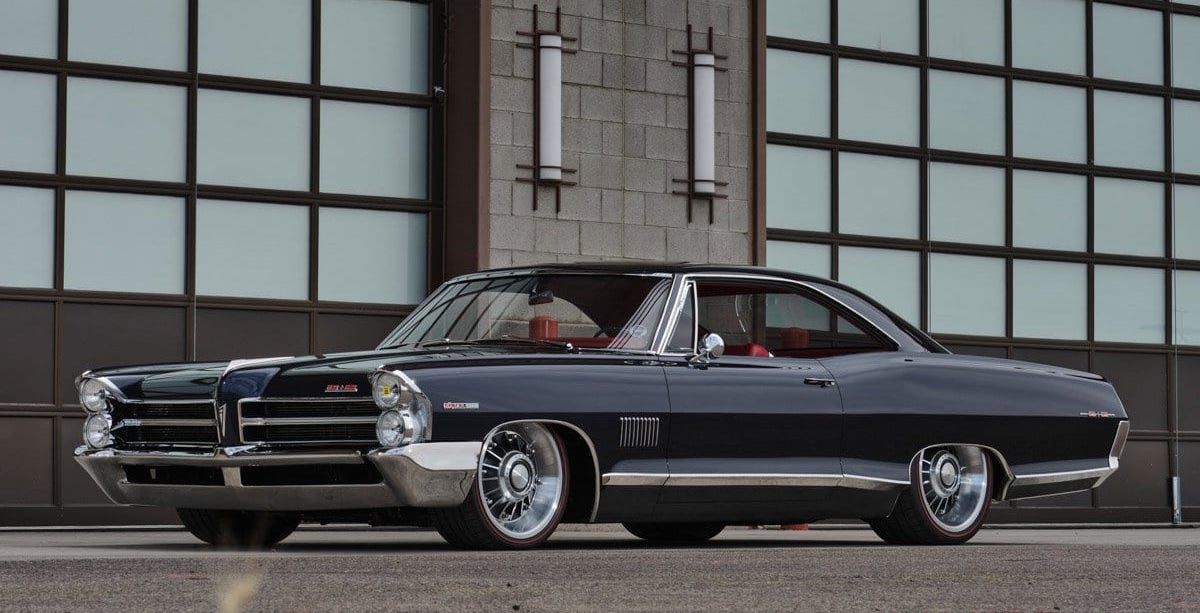The Pontiac 2+2 is a full-size automobile produced by Pontiac with a B-body chassis. It was introduced as a trim only alternative for the Pontiac Catalina for the 1964 models with distinctive door panels, a center console, bucket seats, and an external badging. The Pontiac 2+2 was promoted as the "big brother" to the iconic Pontiac GTO.
The Pontiac 2+2 featured a 6.9 L V8 engine, heavy-duty front springs, dual exhaust and distinctive exterior body design. It remained on the same platform, but for the 1966 models, it became a different Pontiac series. In 1967, the Pontiac 2+2 became an option on the Catalina and was terminated in the USA the following year due to weak sales.
In Canada, the Pontiac 2+2 continued as a series till 1970. All Canadian-built Pontiac 2+2s were outfitted with Pontiac bodywork on Chevrolet chassis, and the whole range of Chevrolet engines from inline six cylinders to big block V8 were offered. The term 2+2 returned briefly in the year 1986 on the Grand Prix 2+2 G-body coupe, which sold 1,225 units.
The Pontiac 2+2: Impressive Exterior Design, Even For Its Time
The Pontiac 2+2 was only offered in hardtop convertible or coupe body styles. Faux louvers on the quarter panels or fenders distinguished a Pontiac 2+2 from the Catalina. Because of the annual adjustments, the look and positioning of the louvers on the fenders varied from year to year.
The Pontiac 2+2 was only available without them in 1964 including the badges that featured on the fenders, bonnet, and interior to distinguish the Pontiac 2+2. The metal trim ran the entire length of the vehicle all along its lower body line and skirt on the 65' and 66' models, and at the mid-door level on the 1967 model.
The pinstripe trim package available on 1965 to 1967 vehicles was another distinctive characteristic. Individual bucket seats were included in the sports cabin. Automatic transmission automobiles came standard with a column shift, floor shift, and console options available. A floor shift was standard equipment in manual transmission autos. The console was available as an option.
The exquisite Catalina dash was also brought over, complete with perfectly functioning gauges. Other available additions do include a console-mounted vacuum gauge to check efficient engine usage while driving and, as an extra option in 1967, a tachometer positioned in the upper left corner of the dashboard fascia and thereafter the hood.
The Pontiac 2+2 Has A Design That Complements Its Interior Sitting Arrangement
The name 2+2 was derived from European sports car vocabulary and refers to a seating arrangement with two in the back and two in the front. It was officially designated as a "regular performance" model by Pontiac, a deeply puzzling designation for a car that was obviously meant to be to the "Catalina" platform what the Pontiac GTO was to the "A-body LeMans." The regular drivetrain was a two-barrel carburetor variant of Pontiac's big 6.4L V8 connected to a floor-mounted three-speed manual transmission.
For better handling, the Pontiac 2+2's suspension was tightened with heavy-duty springs as well as a sway bar. The 389 was superseded in 1965 by a high compression 6.9L V8 engine, with displacement increasing to 428 CID in the year 1967.
Even though the Pontiac 2+2 was no longer offered by 1968, all options (save the Tri-Power, which Pontiac abandoned after 1966 due to a GM edict) remained available, and vehicles could be purchased with what equated to a Pontiac 2+2 without its badges.
The Pontiac 2+2's Engine, Transmissions, And Suspension
The fact that you'll get a regular 421 underneath the hood was a huge part of the attractiveness of the 1965 and 1966 Pontiac 2+2. The basic engine for the Pontiac 2+2 was a 338 horsepower, 4-barrel 6.8 V8 (designated YH for auto or WG for stick). Alternative engines also included the 356hp Tri-Power (code YJ auto or WH manual) or the 421 HO, estimated at 376 hp and marked WJ (manual) or YK (automatic). Engine codes for all Pontiac are crucial. Because the external block specifications for all Pontiac V8s from 326 to 455 cubes stay the same, you will want to make absolutely sure that you've obtained the actual code for your vehicle.
The Pontiac 2+2 transmission had the traditional 3-speed stick, new for the 1965 turbo 400 and a huge improvement over previous generation auto transmissions. The Hurst-shifter Muncie 4-speed stick was also available in the Pontiac 2+2; the big vehicles received a longer tail shaft. Back main seals made of rope are infamously leaky; neoprene seals are provided. Hurst is currently rebuilding Hurst links.
In the aspect of its suspension, the B-bodies have A-arms and coil springs with a .875 inches anti-roll bar at the front and coil springs with 4 control arms behind. The heavy-duty suspension kit was standard, with ride rates at the wheel rated at 90 in front and 125 at the rear. Special orders might be placed for even stiffer springs.
Sources: Pontiac2Plus2Registry, Hemmings, MotorTrend


.jpg)
-1.jpg)
-1.jpg)